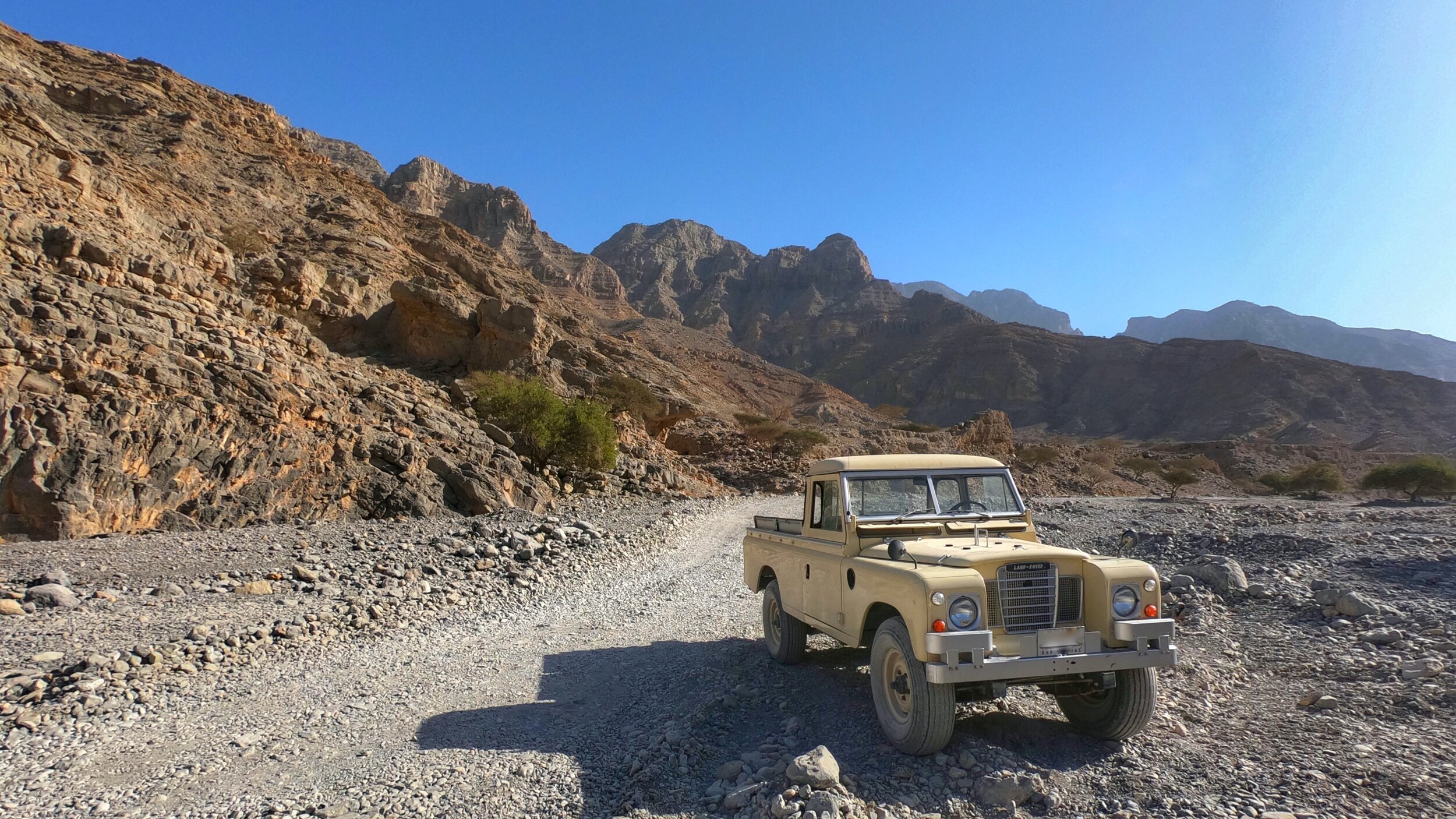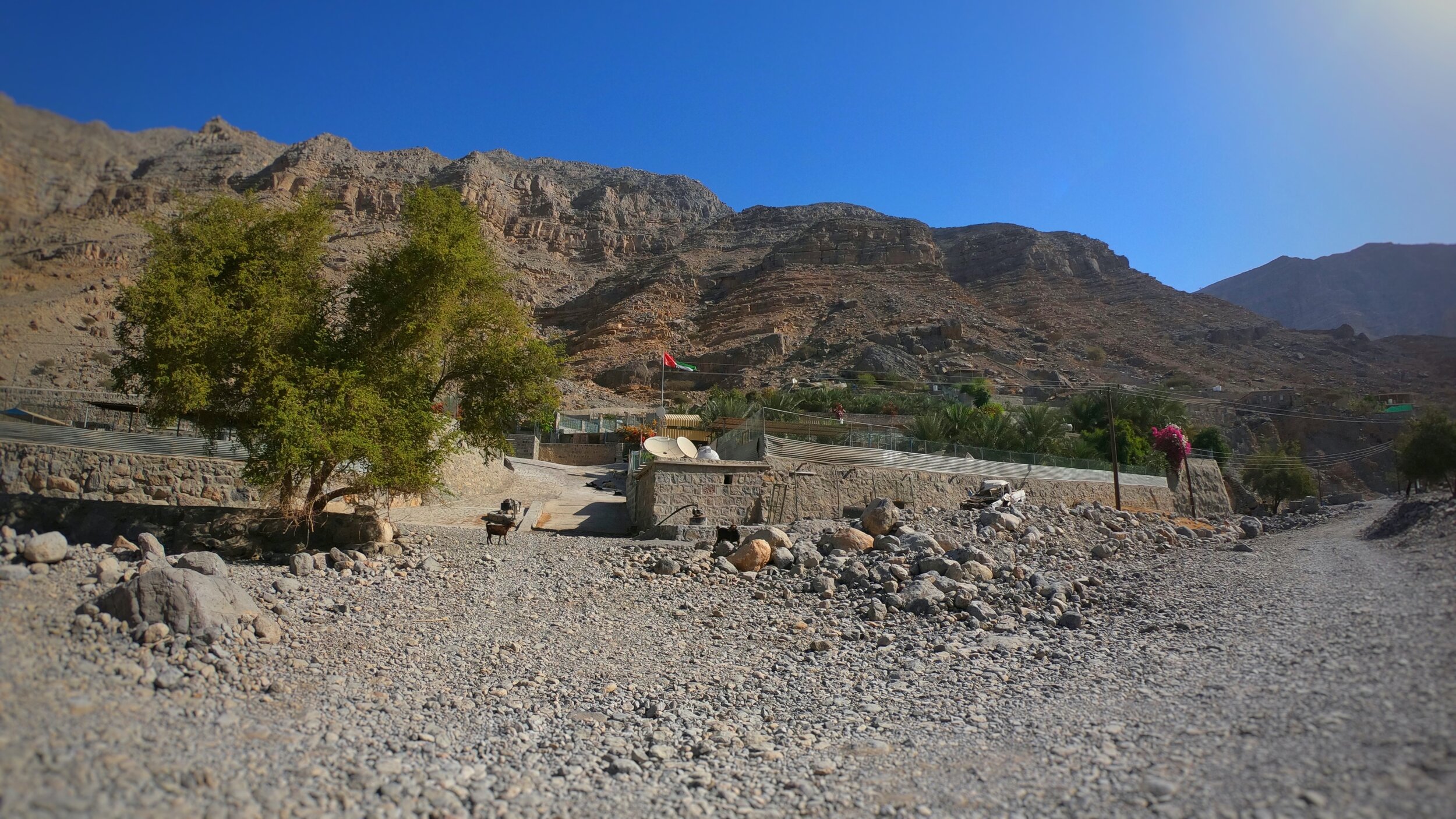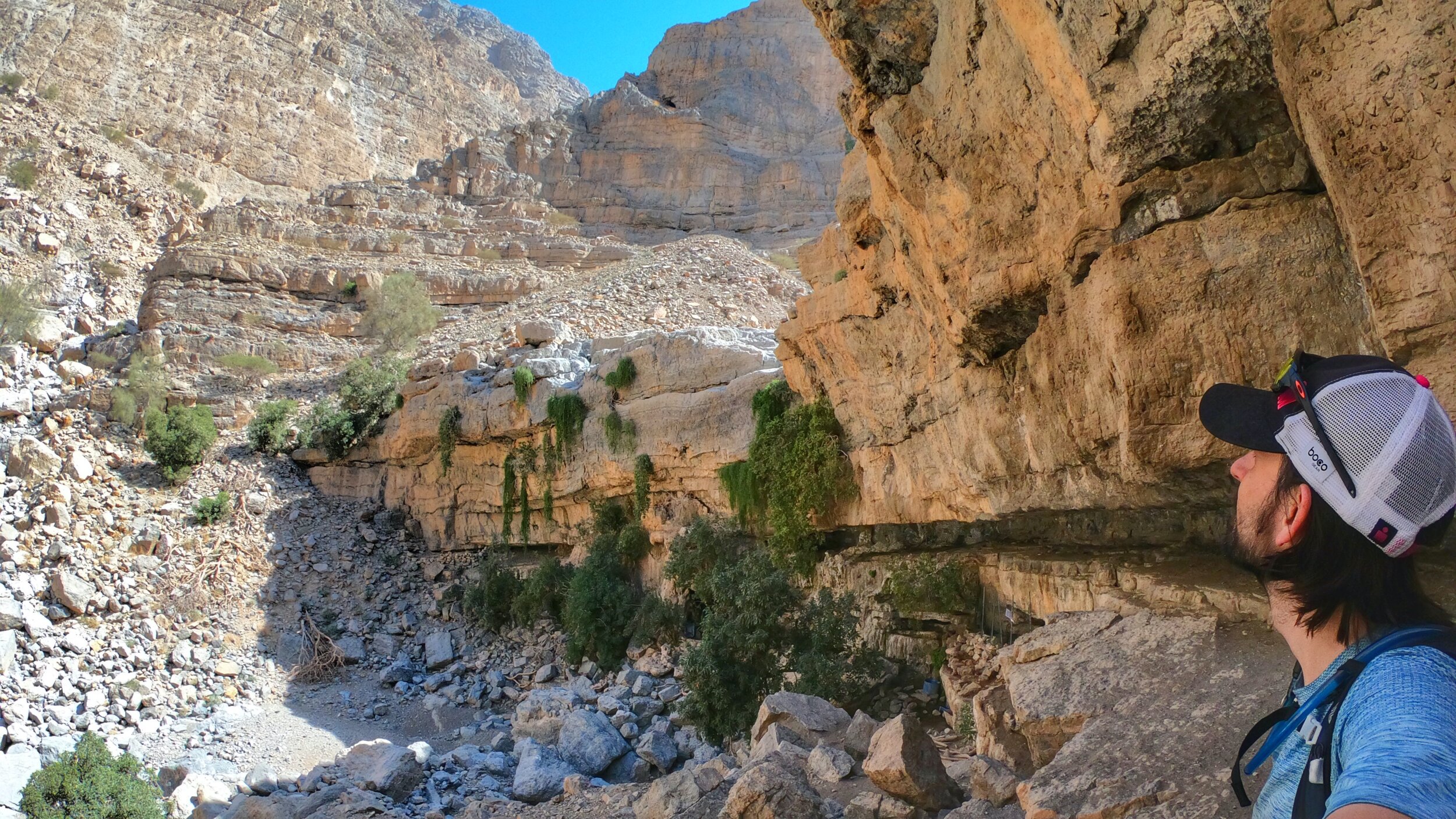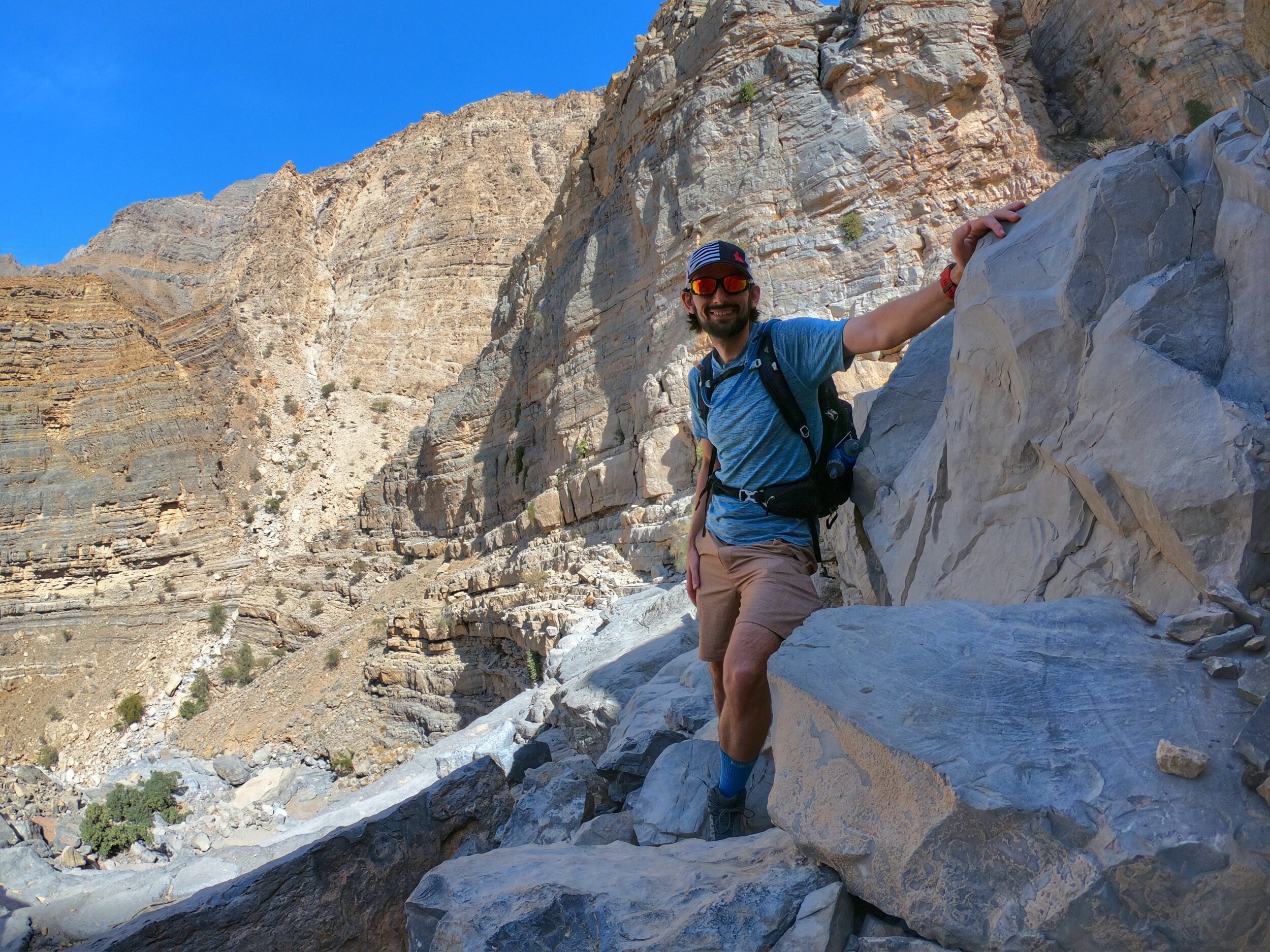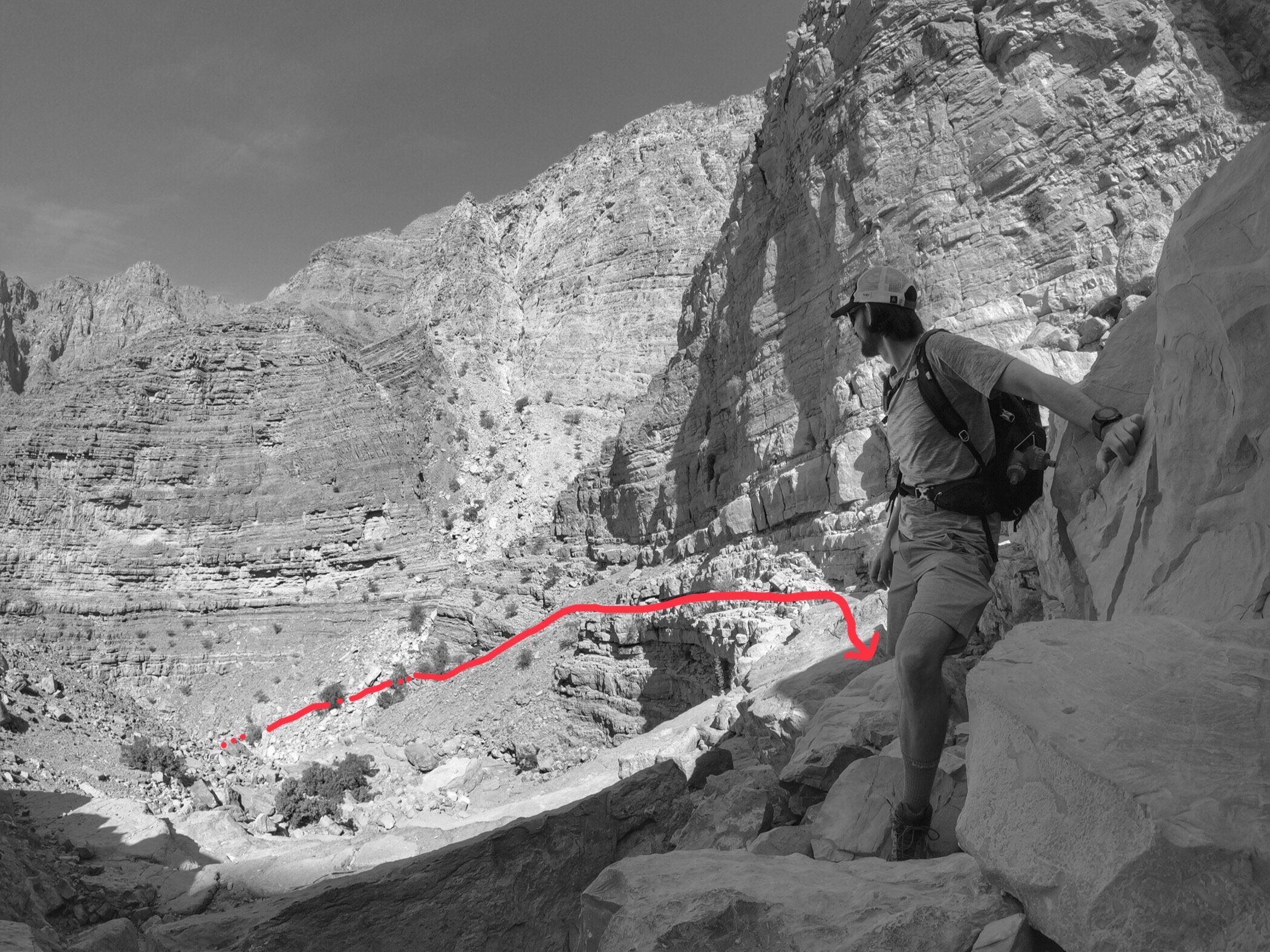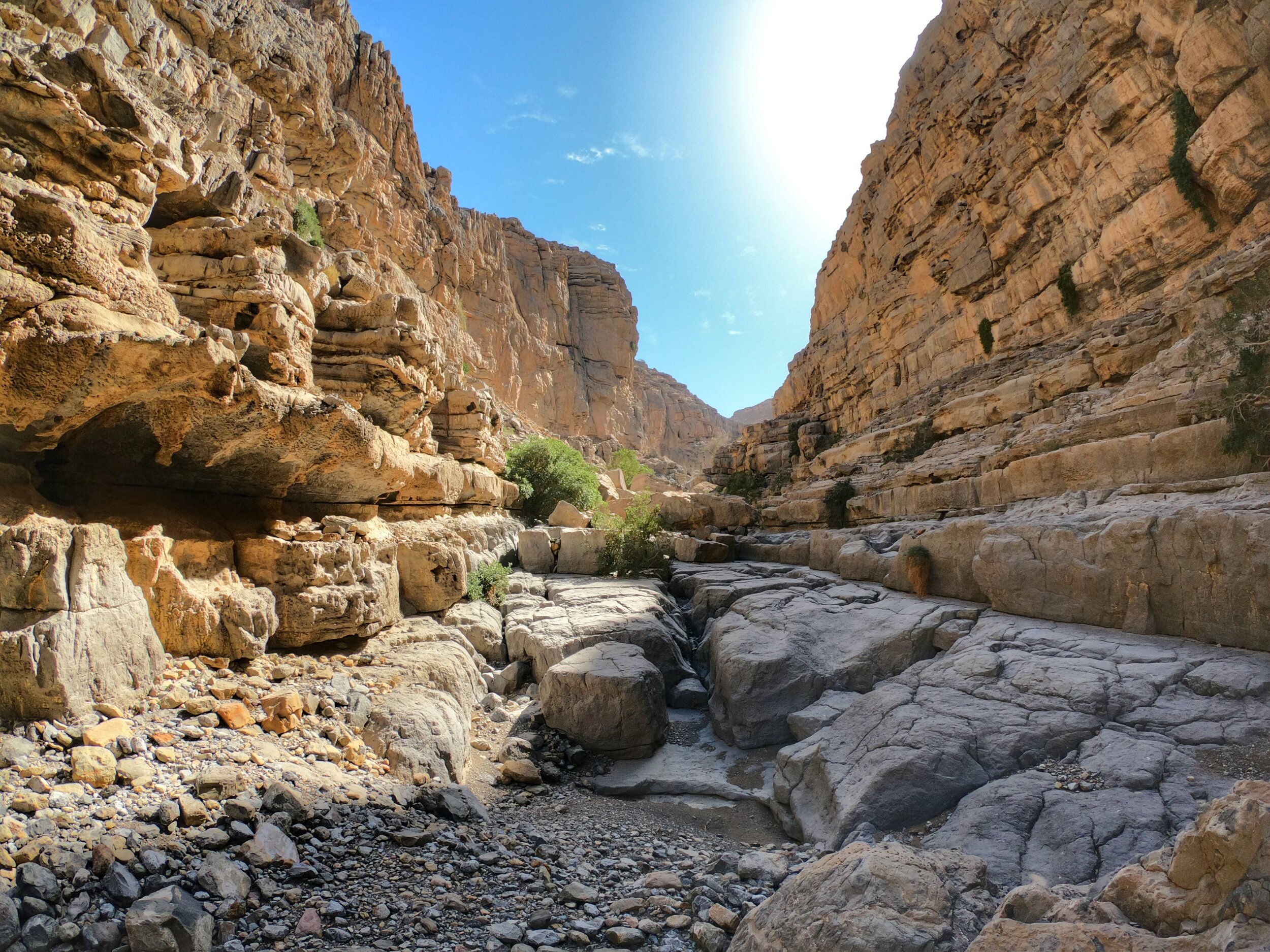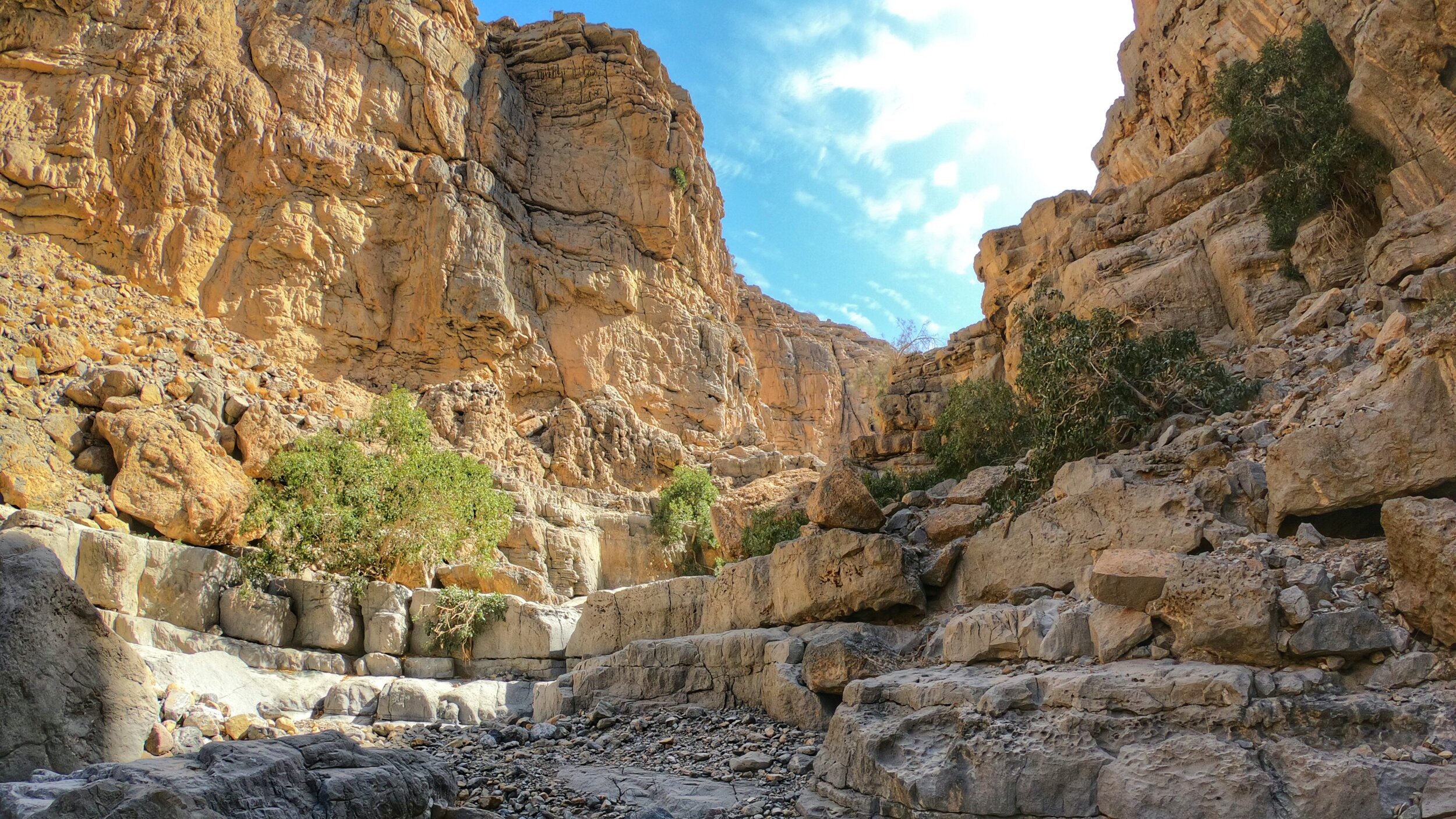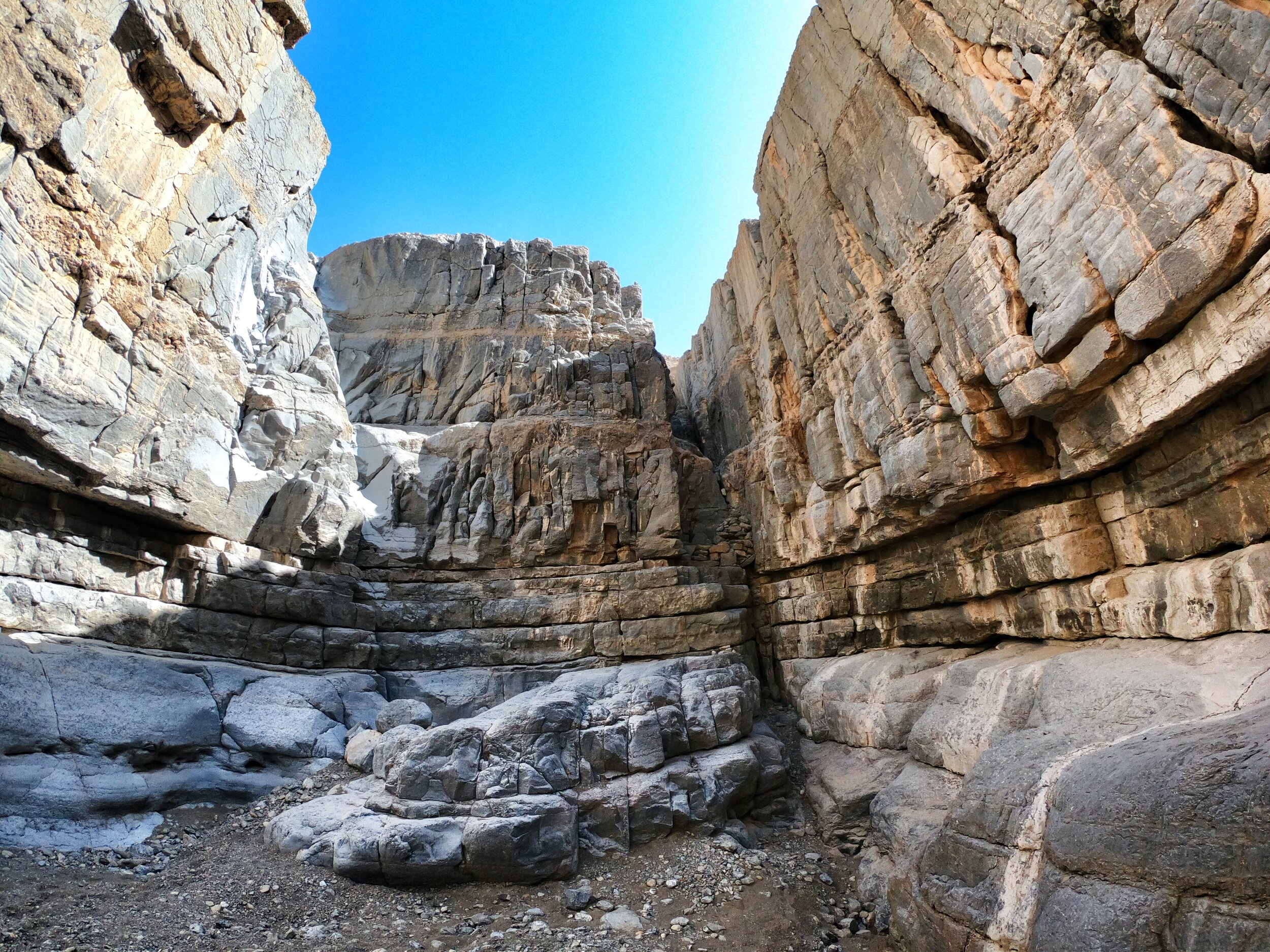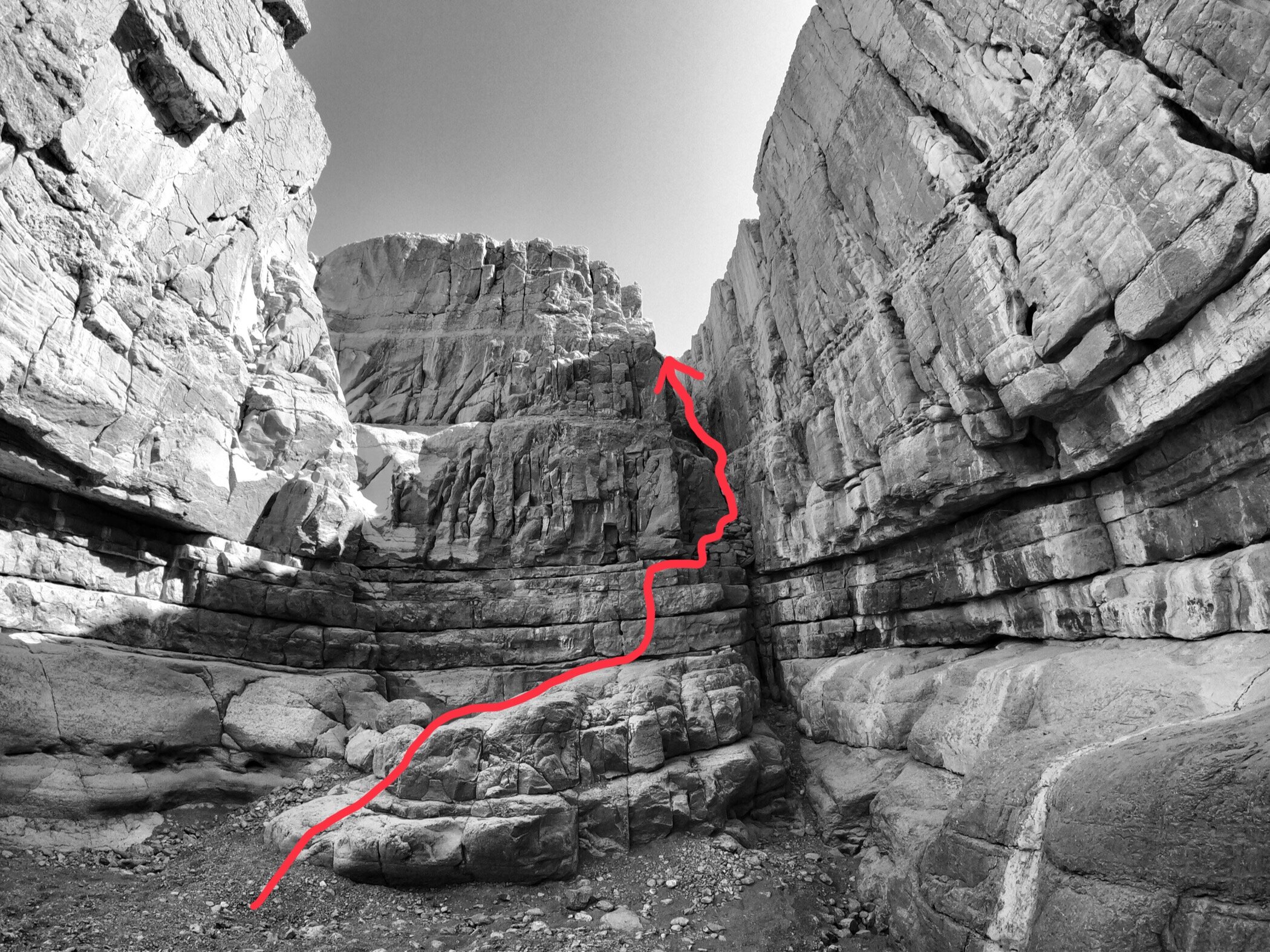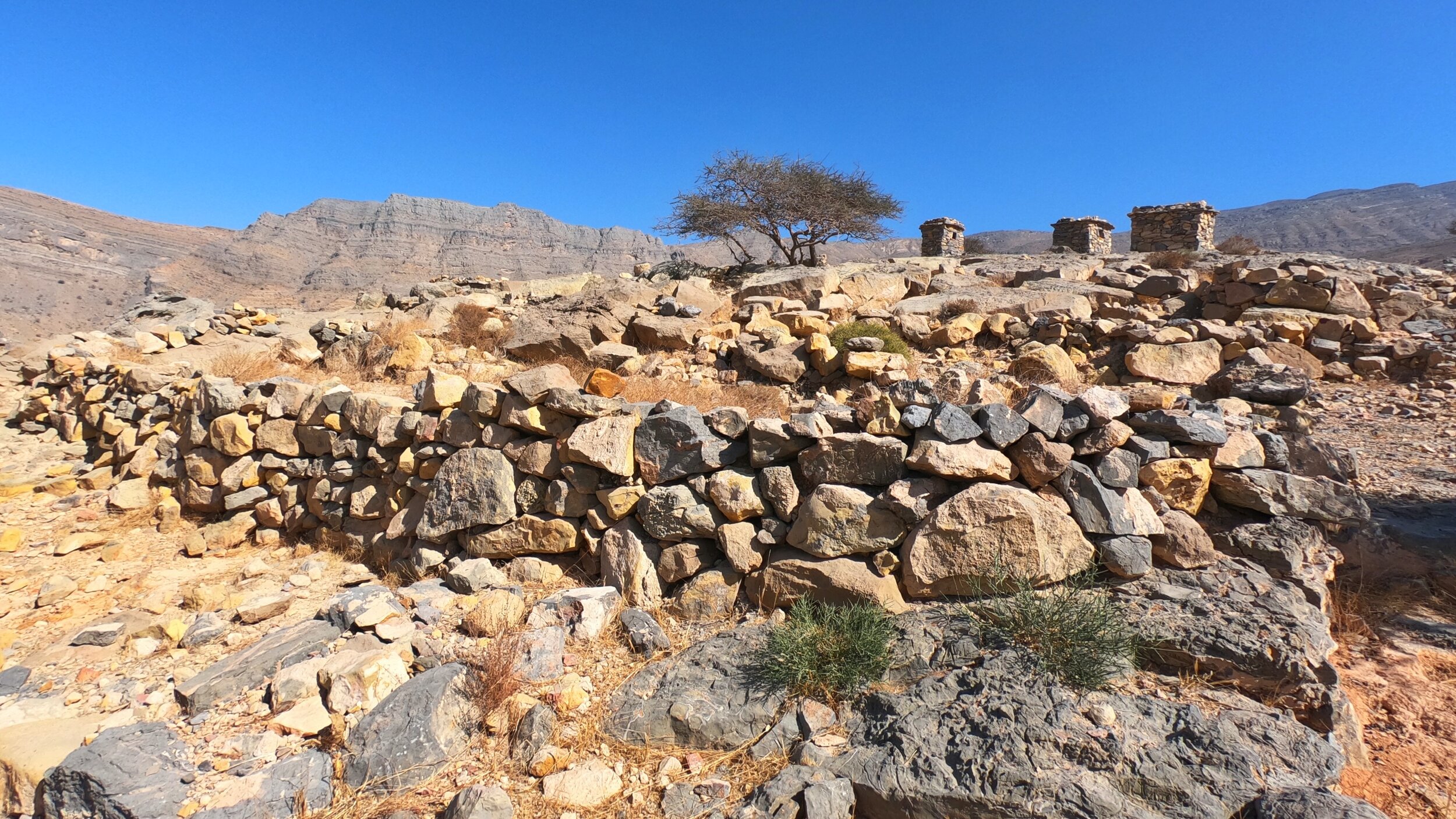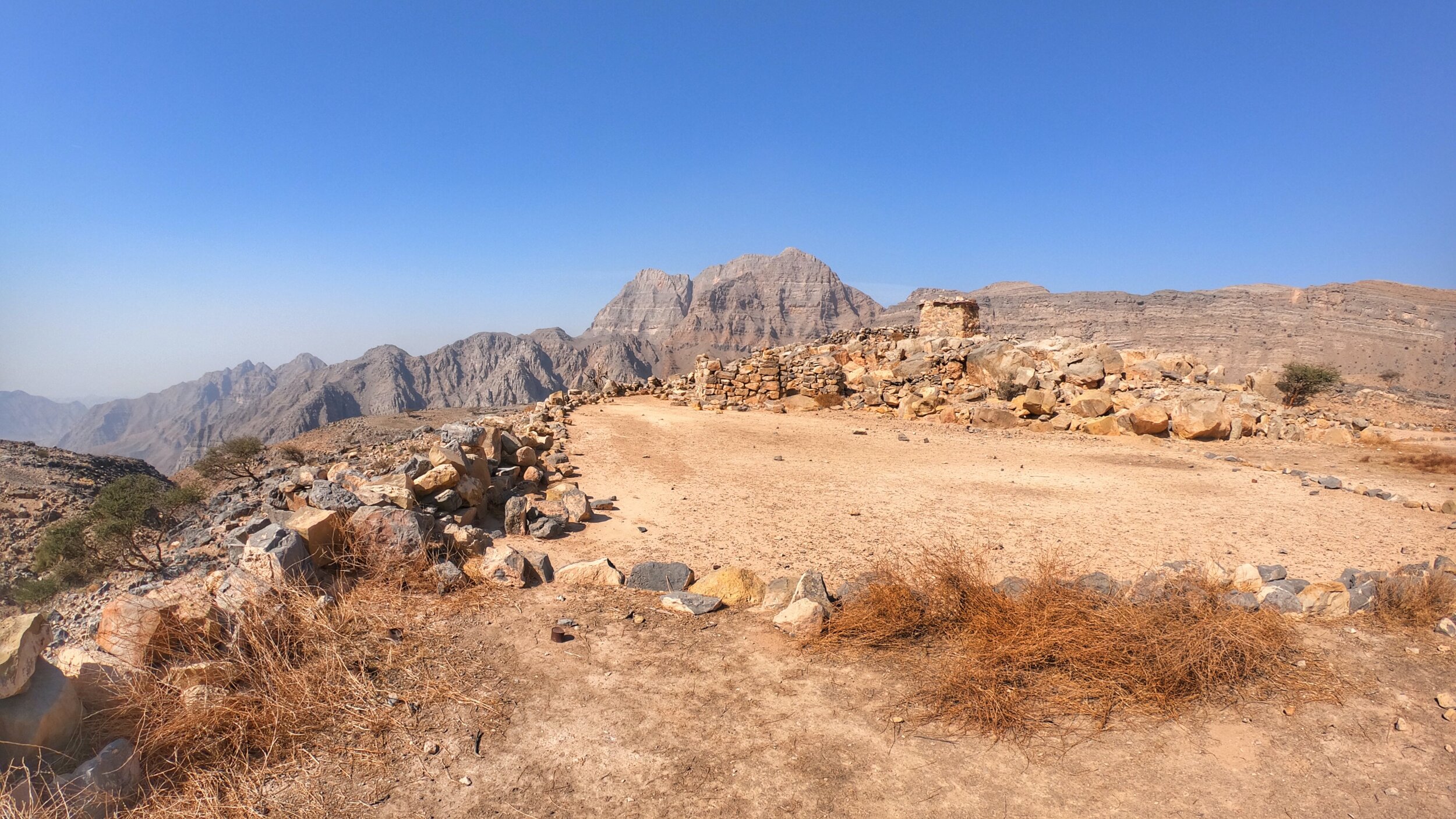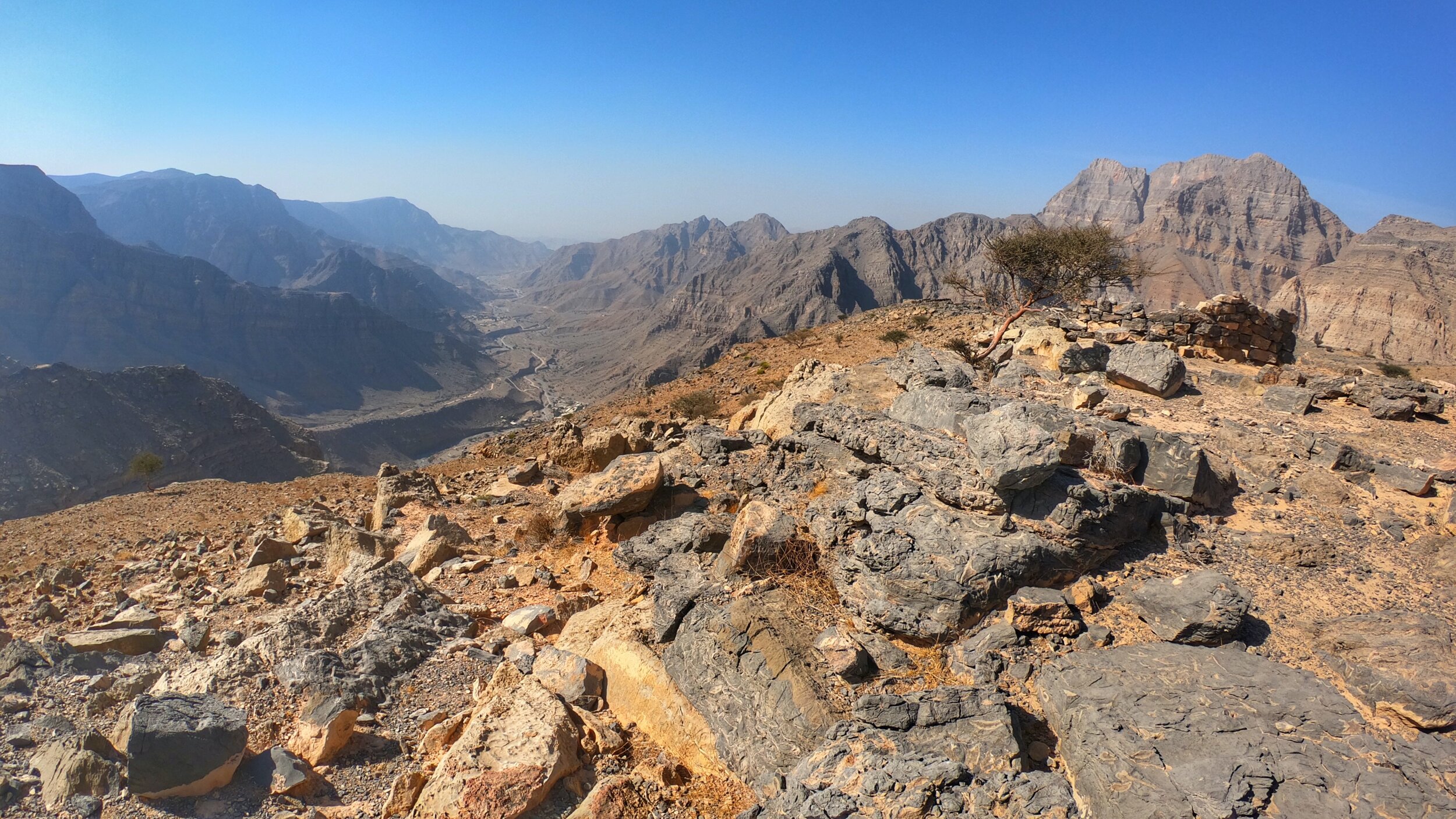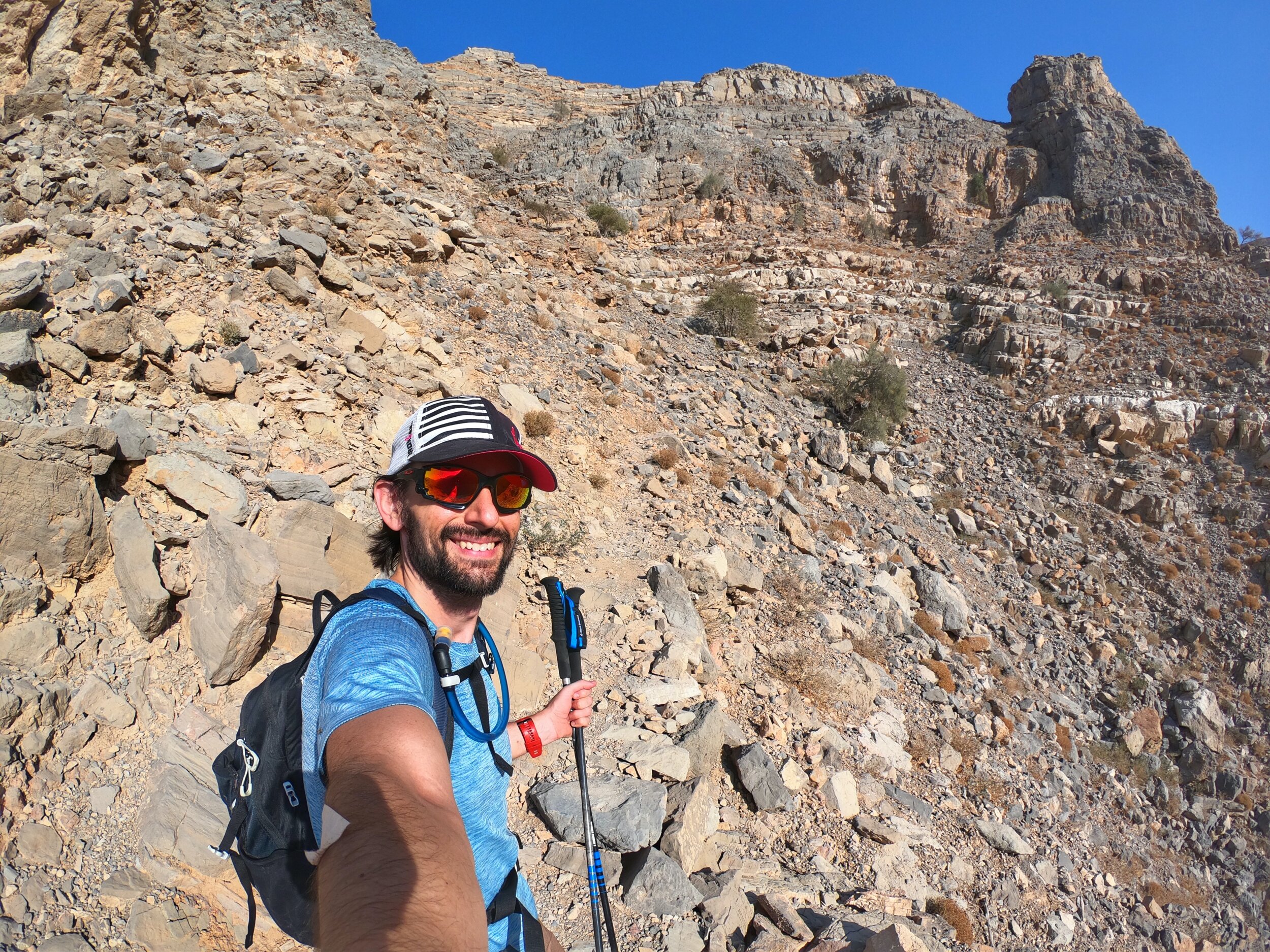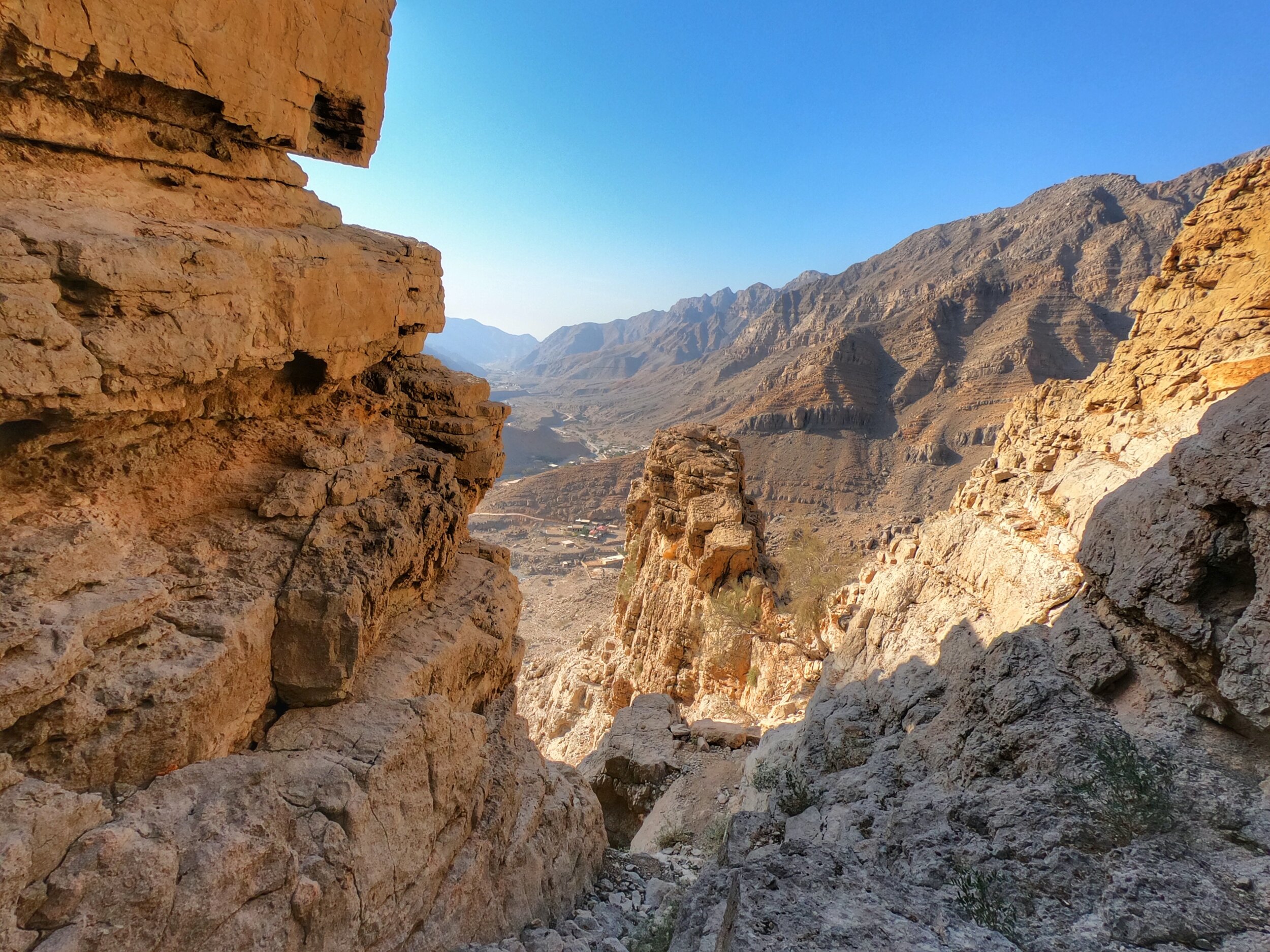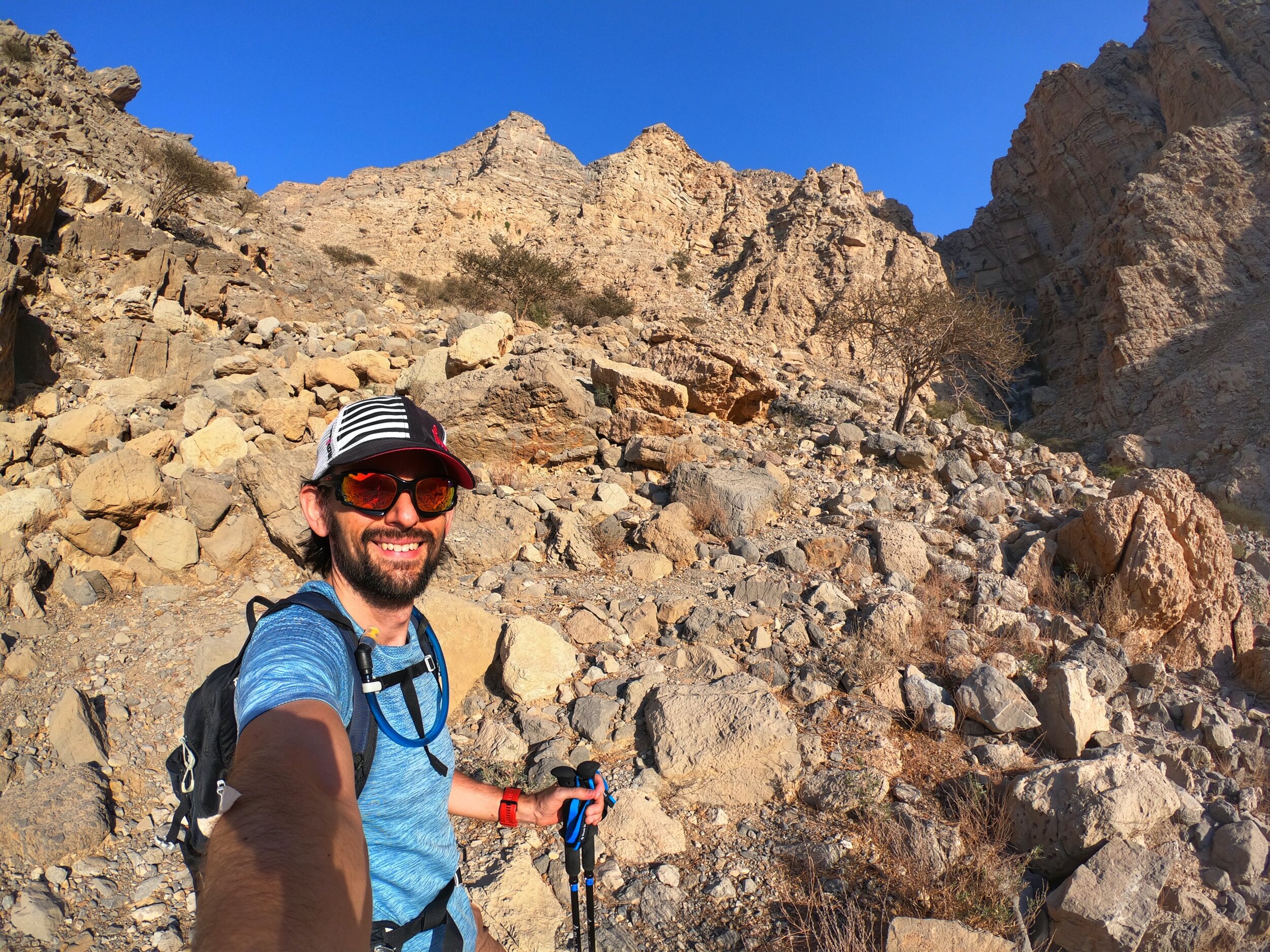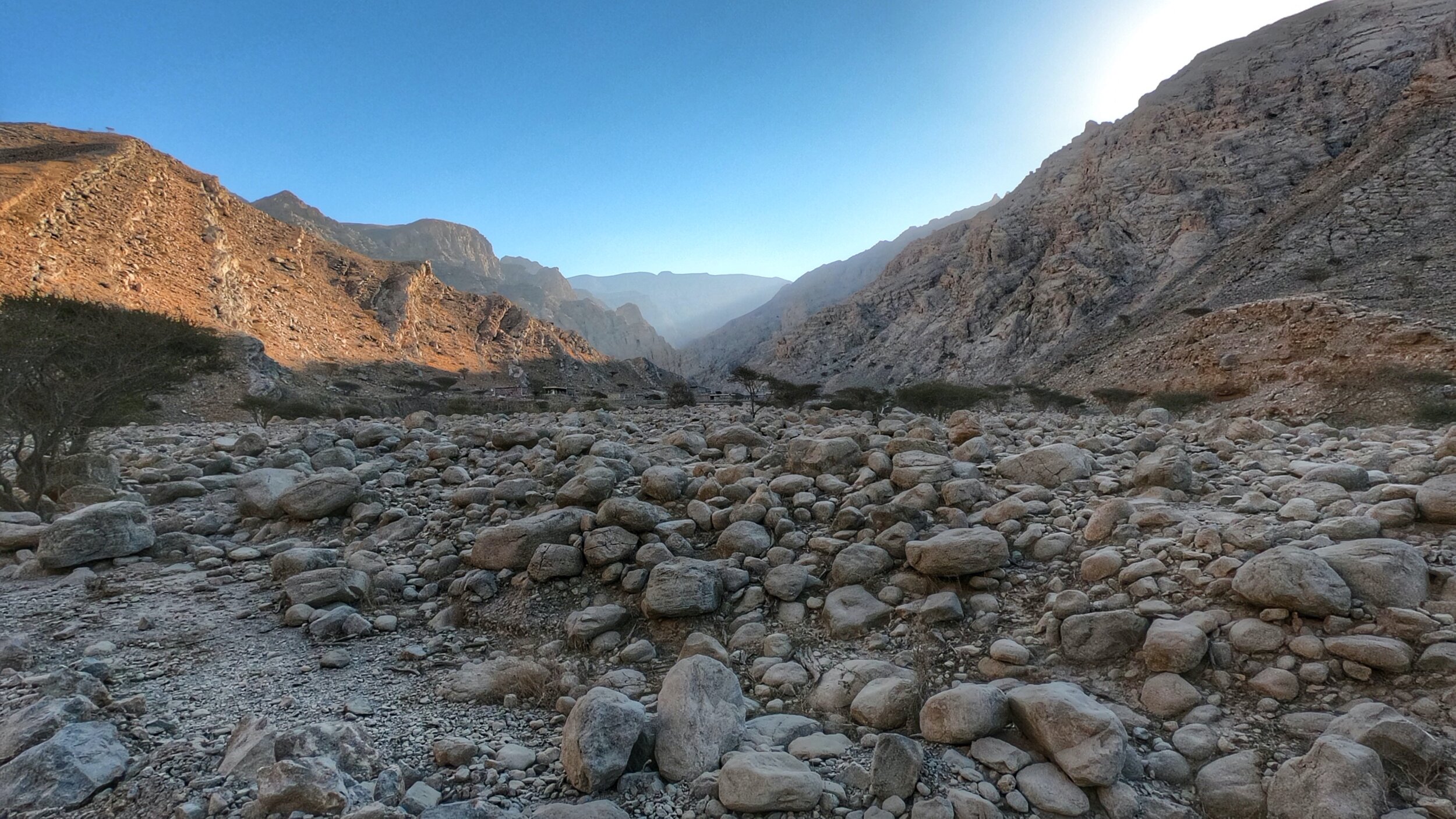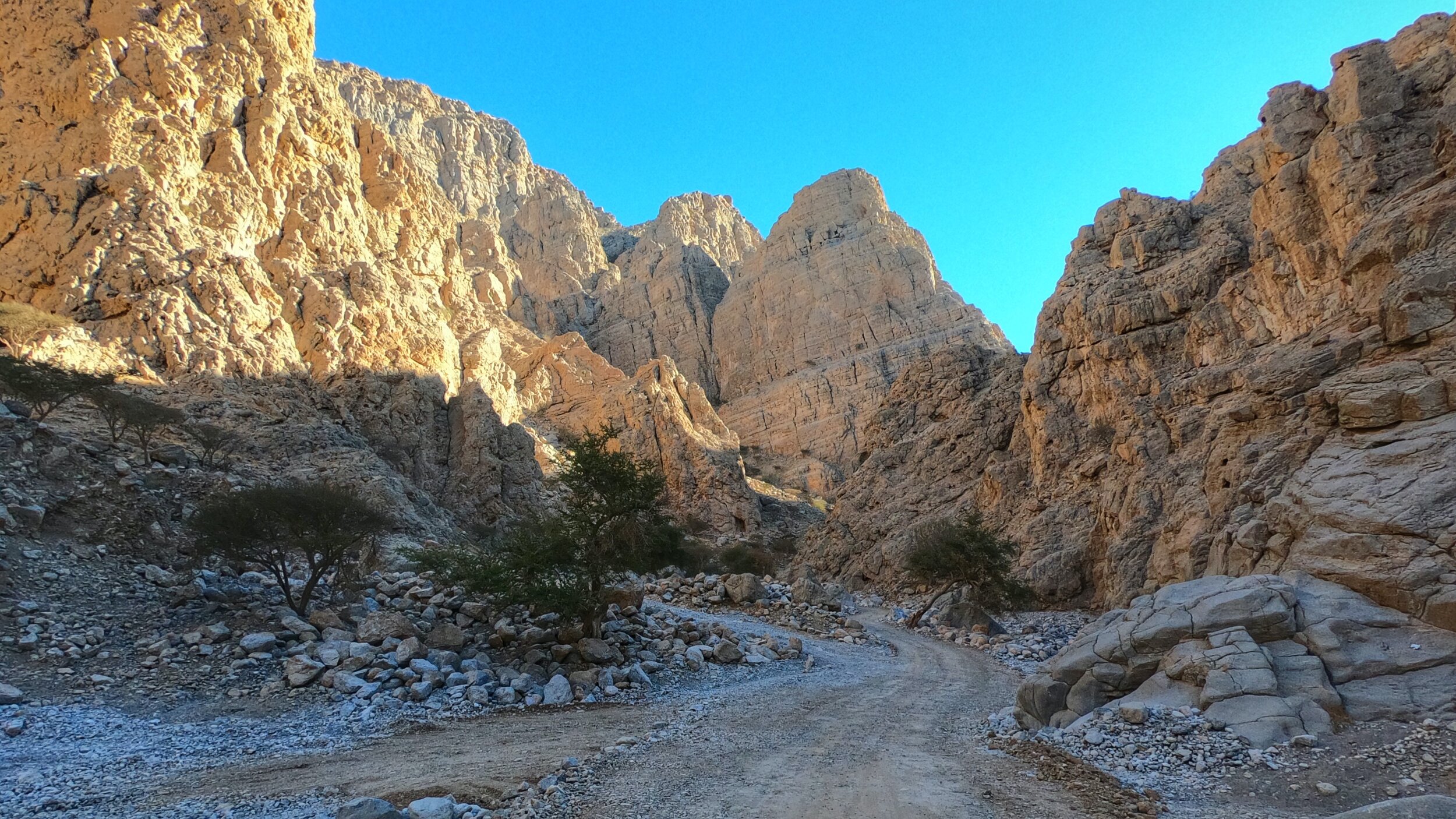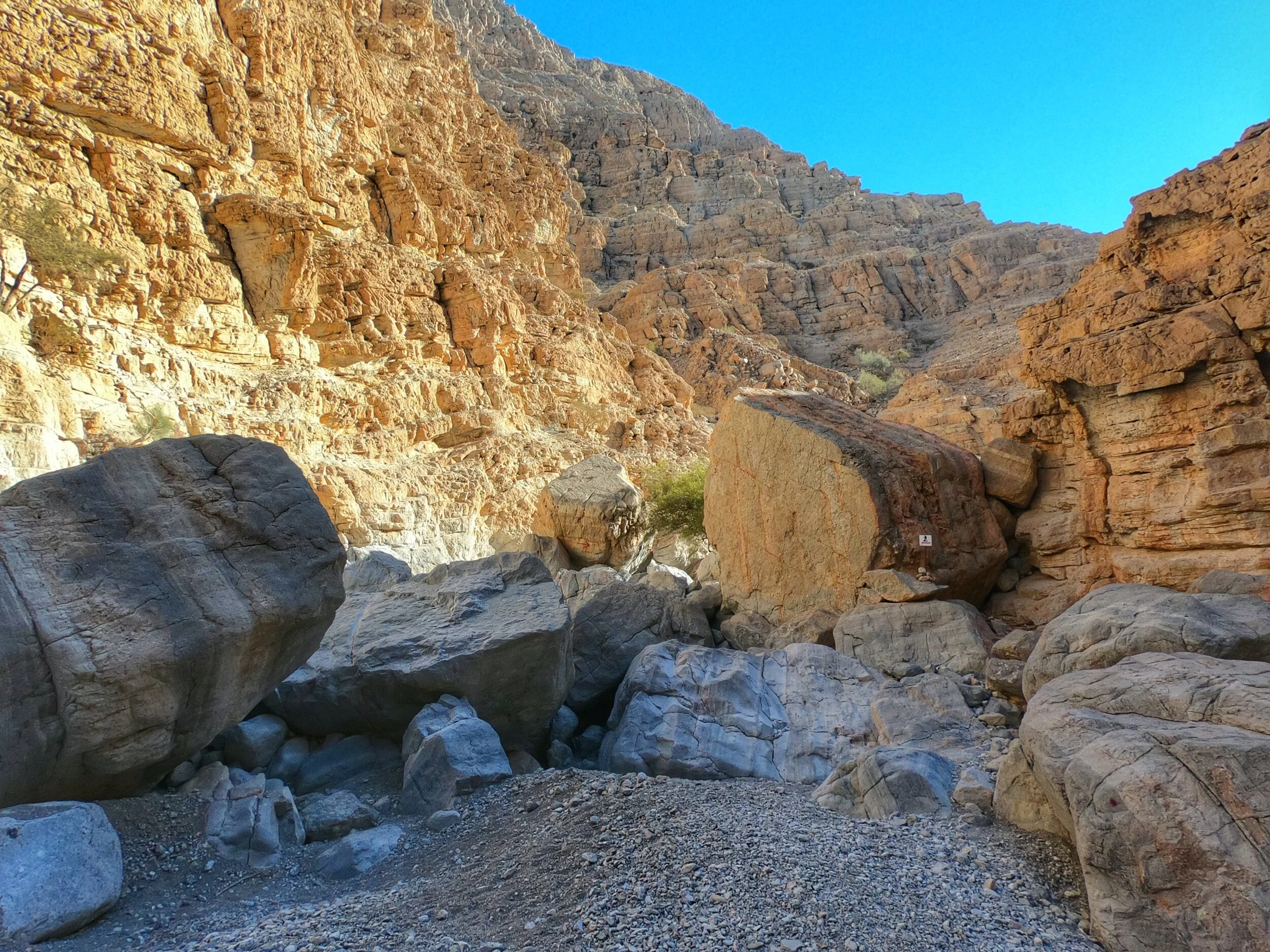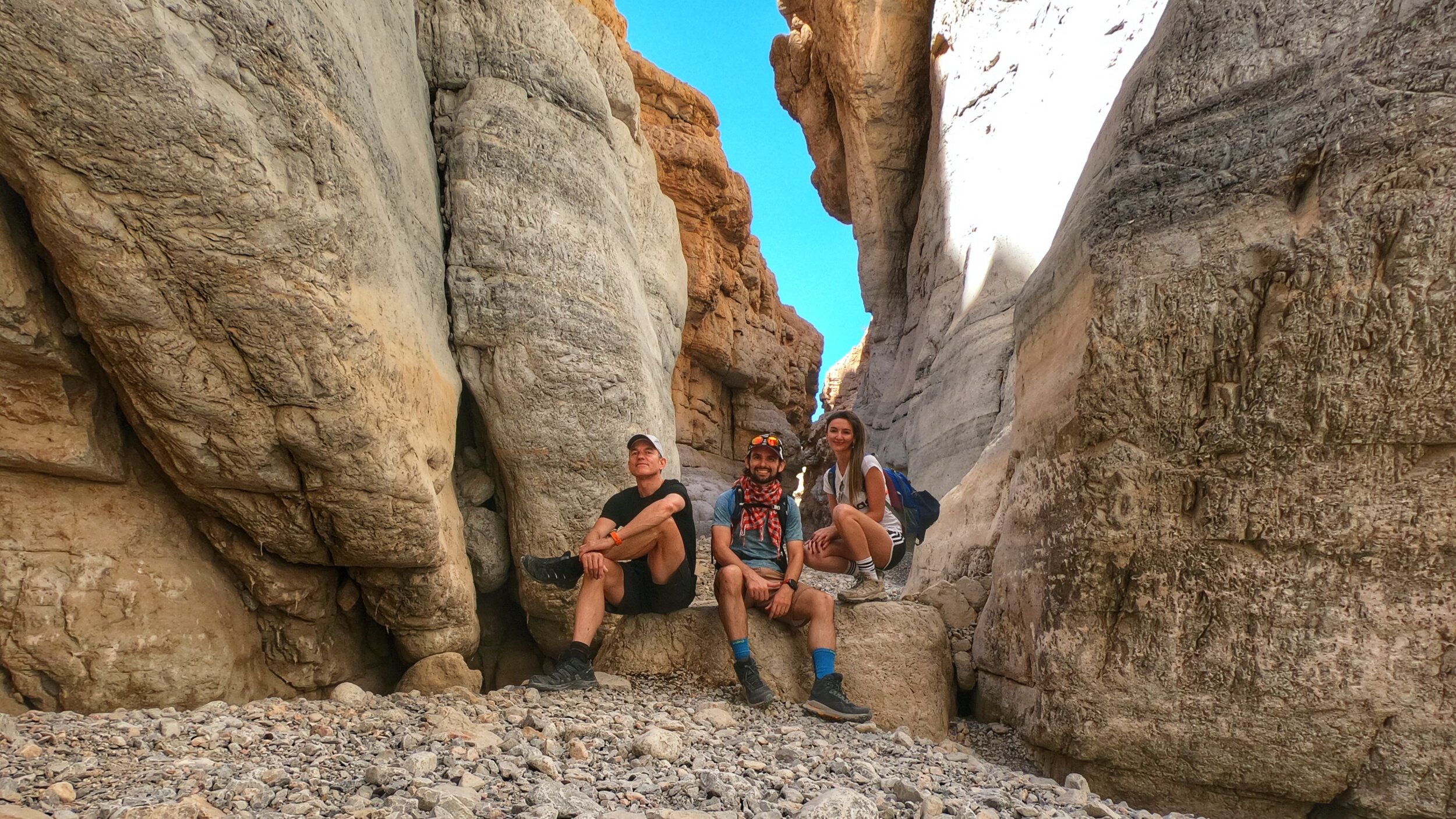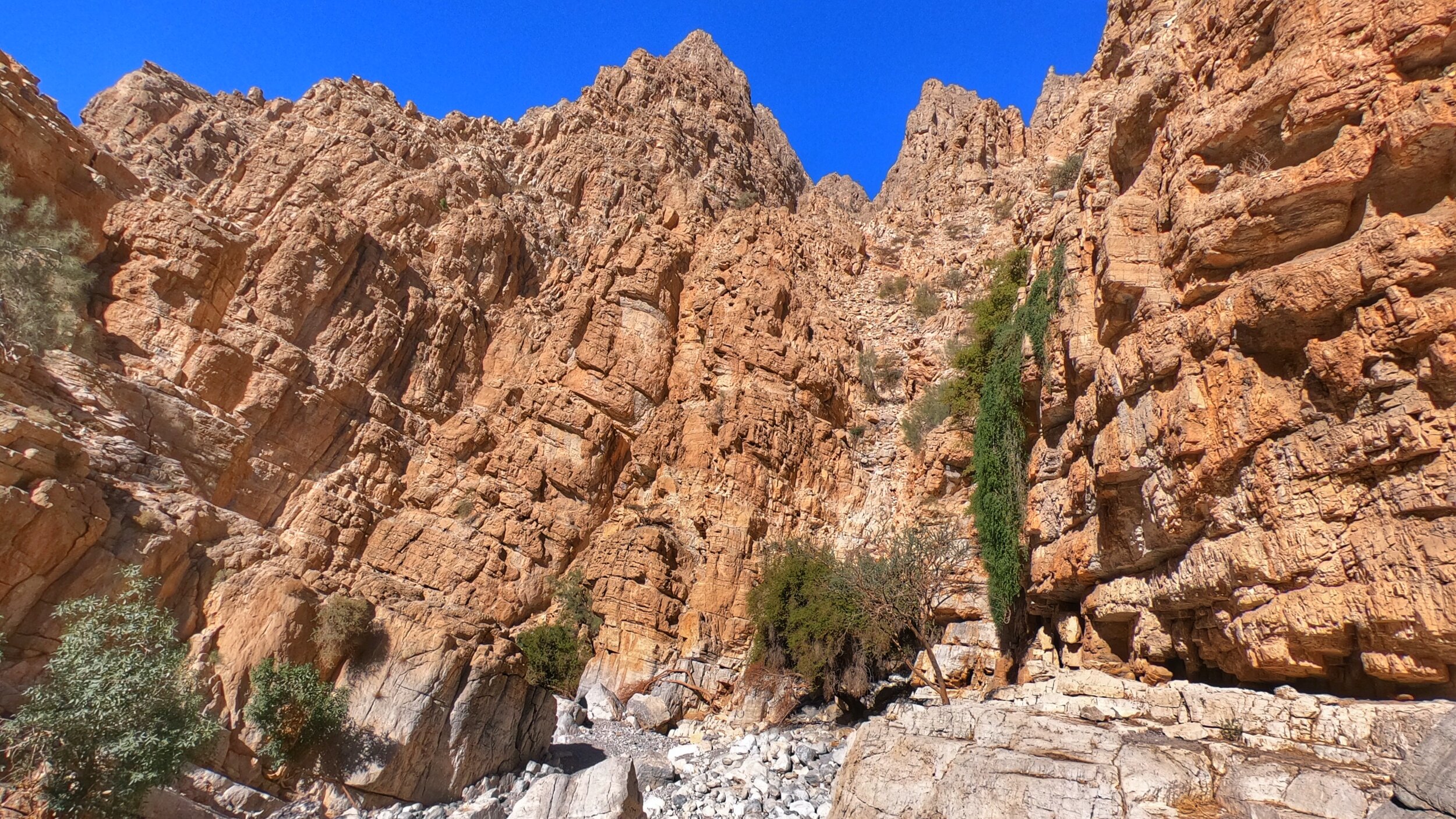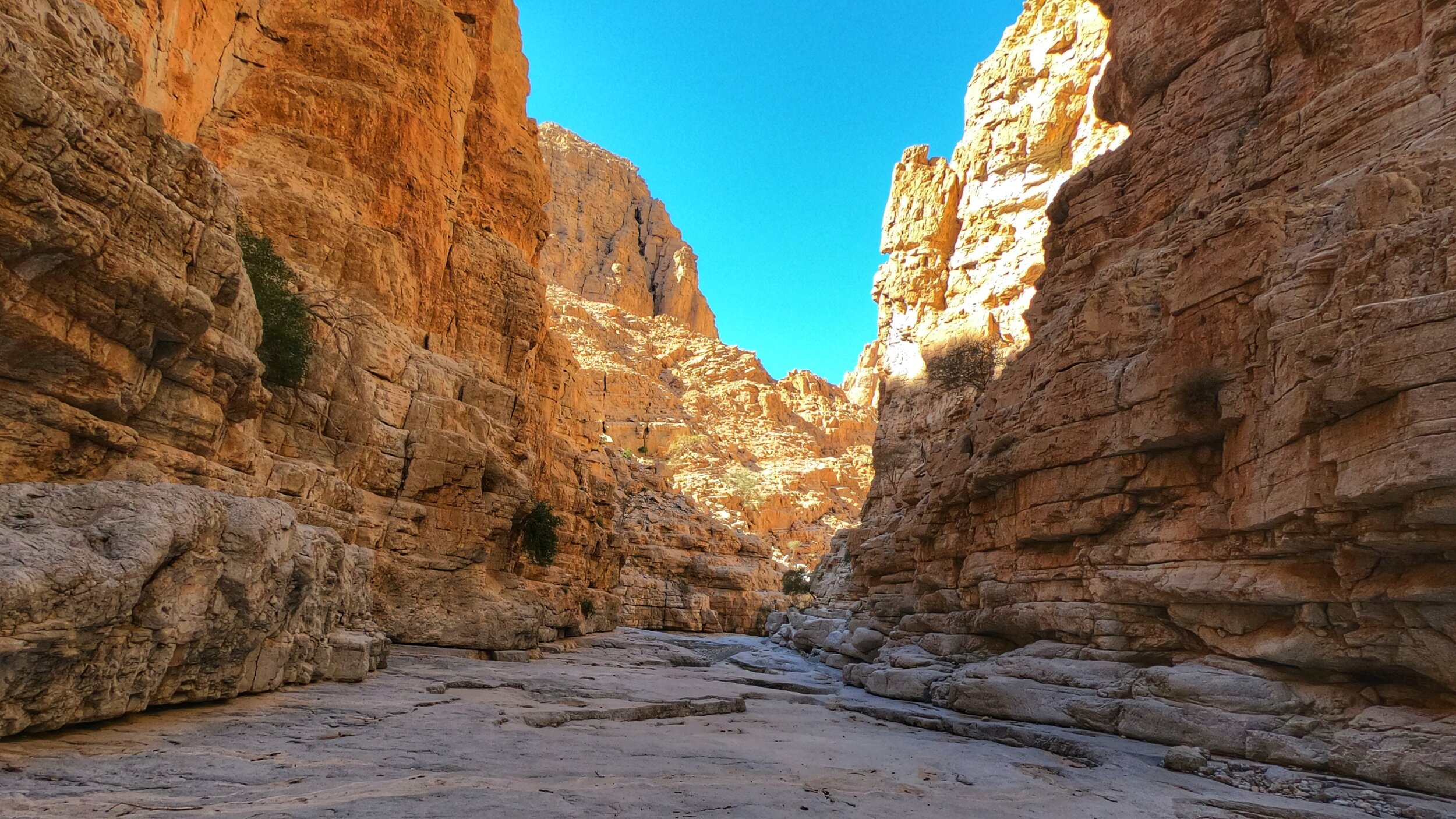Leopard Canyon (Ras al Khaimah)
Leopard Canyon, apparently so named as it was the site of the last ever recorded live example of the wild Arabian Leopard, is situated up in the mountains of Ras al Khaimah, en route to Jebel Jais. I had heard positive reviews of it's natural splendour and having really loved some of the hikes in this part of the Hajar range decided to look into a visit.
I am naturally cautious whilst still enjoying some adventure. What this essentially means is that I am not one to simply set out blindly and 'explore' in the pioneering sense. There will be no new trails attributed to my name as I am certainly not looking to put myself in any unknown harm's way by venturing off into uncharted territory. As such, I spent some time researching this hike, reading blog accounts and reviewing the route on Wikiloc, as well as downloading the GPS file onto my own Garmin, which I intended to then follow. As a result of this research I knew that it was not a really easy going hike and there were one or two more technical sections to contend with. However, what I did not appreciate via this 'armchair research' was just how tricky some of the sections would prove to be in the real life, wild setting, where there were actual repercussions in the event that things went awry. I now appreciate fully a couple of very important considerations in relation to this specific hike:
1. Do NOT attempt this solo.
Whilst I have trail run and hiked perfectly safely in a solo capacity before, and routinely put in place safety measures such as confirming my plans with a friend, checking in with them as I set out, giving them a check-in-by time and then confirming my safe return, in addition to researching the route and as much information as I can, plus taking all of the essential kit, this hike felt unsafe at one point in particular. Whether having someone else present would have in any way reduced the actual risk level is up for debate but what having a co-hiker does is provide a degree of reassurance that were something to go bad, someone would then be able to react and either provide help or call for assistance. The section in question was one where a climb was involved - in hindsight it was not an especially high or tricky climb but the fact is that a fall at that point could have been quite nasty, with a drop of at least 6-7 feet down between a narrow rock gap. A fall of that nature, whilst unlikely to be fatal, would probably result in a quite serious injury and certainly impede one's ability to get back down the mountain unaided. I'll discuss this particular section in more detail below.
2. Ensure that you complete this during daylight.
I did manage to complete this route in daylight and was mighty glad I did as there were parts of the second half (technically the descent) where there was absolutely no clearly marked trail and what simply looked at first glance to be impossibly steep slopes and drop-offs. How on Earth anyone would manage to descend safely in the dark is kind of beyond me. This hike took longer than perhaps I was initially expecting as the distance is misleadingly short. However, throw in the technical nature of the terrain and the fact that there is no real trail to speak of and the time required to safely navigate it increases. I set out at about 9.30am - I would have preferred an earlier start but was delayed by heavy fog in Dubai that impeded safe driving - and got back to my car by 5.30pm, and this was baring in mind that I did not stop for lengthy periods of time during the hike itself.
Finding the Hike
Driving along Wadi Bih towards Jebel Jais, the road curves round to the left at the southern end of RAK Lakes. At this point there is a small tea truck parked up on the right, just beyond a huge sign for Challenging Adventure, with arrows pointing towards it. This is the turnoff towards the start of the hike and so I turned right, following the dirt road past the aforementioned adventure centre and towards the village of Sal. I chose to park up a little before the start point provided on Wikiloc on account of not driving a 4WD and preferring a bit more walking compared to getting stuck and so found a suitable 'layby' to start from. There are a number of signs as you drive down the wadi stating something to the effect of 'Residents Only,' but were these to be religiously adhered to then the first part of this hike would be about 5km longer each way. I figured that as long as I didn't encroach on anyone's access and kept a low profile then as one inconspicuous hiker I should be ok to bend the rules a little.
As I set out from my car, heading towards Sal and then into Wadi Ghail, the temperature was already up in spite of it still being mid February and thus winter. With sufficient water, electrolytes, food and other relevant kit in my possession, and having slapped on sun screen, I figured that it probably wouldn't get much warmer than it was, a judgement that proved to be accurate. Flat going for the first 5km, the road took me past the scattered farms of Sal, between vertical, crumbling banks of layered rock, eroded over the years by successive floods during the infrequent rains, and ultimately uphill past what I have always assumed is some sort of remote military border station (small, square towers that look to have, maybe, radar attached) and past two farms that mark the entrance into Wadi al Nimr.
Wadi al Nimr to Hanging Gardens
Whilst there is no really clearly marked out trail at any point on this hike route, there were some sections where it was possible to make out boot marks in the dirt, and even some very short sections in which an actual trail could be seen worn into the terrain. As such, I was relying both on the GPS route I had downloaded onto my Garmin and the fact that the wadi itself swept up and round to the right, leading towards the Hanging Gardens. Picking my way up and through this wadi was a gentle introduction to some relatively simple bouldering and route picking, with the Hanging Gardens eventually coming into view.
There are, in fact, no actual 'gardens' to speak of, rather two large steps in the valley, which if water was flowing, would make for two impressive waterfalls. Naturally sheltered from the sun and with a smattering of vegetation clinging to the sheer rock faces and a series of low ceilinged ledges, this felt like a lovely place to take a few minutes in order to recharge the biological batteries, snap a few pics and watch the occasional goat as they sought out some water from one of several plastic drums clearly placed here by their owners.
From the first 'garden' the route heads up the left hand side, into a scree slope that threads up to a rock ledge. Walking along this ledge ultimately brings you onto the top of the second 'garden,' with a bit of scrambling required to reach the very top of the entire section. The views down the valley from here are spectacular and it felt like an immense privilege to have them all to myself.
Leopard Canyon
This part of the hike marks the start of the actual canyon itself and as the trail weaved ever deeper inside and the cliffs on either side seemed to tower ever higher, the sense of entering a hallowed place was palpable. The acoustics in this part of the mountains was almost eerie, with every footstep and crunch of the fine pebbles underfoot amplified by the canyon's narrow channel. At one point all I could hear was the recurring coo of a dove, which when amplified in such a remote, isolated spot took on an almost spooky quality.
This was by far my favourite part of the entire hike, just as with Wadi Naqab, as the shapes, colours, sounds and entire atmosphere in the canyon was just magical. Traversing this section of the hike did involve a little climbing, although nothing ever higher than about 2 metres and all with very secure, reliable hand and foot holds. At no point in this earlier part of the canyon did I feel out of my depth - that was to come!
The end of the canyon section of the hike is marked by a large immovable wall of solid rock with a narrow channel cutting up and through to the right hand side. I had been expecting a section that required a "bit of climbing" and had even seen a photo of it but what I hadn't really truly appreciated until faced with it for real was that the climb was more vertical than I had been expecting, relied in large part on a bunch of piled up rocks that did not look in any way stable or reliable and, were things to go wrong, such as losing grip or a foothold, the fall to the ground was not short and happened to involve landing in a narrow split between rock faces, assuming that one managed to miraculously avoid hitting any of the rock surfaces on the way down. This was the point at which the challenges and skill level required from this hike truly hit home. As I recced the route from the point at which the stone pile was found it dawned on me that this might be too much risk for me to comfortably handle, especially on my own. As mentioned before, I do consider myself to be adventurous but not reckless, and this was starting to feel like the latter. My main concerns were what would happen if one of the footholds or grips gave way unexpectedly once I'd already committed to them, in addition to concerns about something that could potentially sting or bite hiding in one of the hand-holds. As I peaked up the rocky channel I saw a goat en route down the very one that I was contemplating ascending. Good job I checked first as that would have been just my luck: committed to a dangerous climb only to have a bloody goat knock me off! Thankfully Mrs Goat saw me and decided that she'd prefer to be some other place.
Whilst the route was now clear my head still wasn't and I could feel my nerves start to set in. As I tentatively tested the stability of the rock steps in a bid to satisfy myself that the risk was sufficiently manageable to allow me to press on, matters were not helped by one of them wobbling. At this stage I did actually down-climb a bit, pausing to really consider my options: turn back and re-trace my steps, even though I knew that the descent was going to be way trickier, especially on the scree slope, or commit to this climb and complete the circular route. After settling my nerves back down and telling myself that it would be a shorter trip to complete the circle (not ultimately the case it turned out) I climbed back up to the same spot, positioned my hands and feet, testing the stability several times before whispering a silent prayer and stepping up, thus committing to the move. There was now no turning back - I was either going to get up this section or fall, with the latter not even bearing further thought. Before I knew it I was up in one piece, the scariest part of the channel climb complete. Phew! The rest of the climb was simple as there was no more exposed vertical ascent to content with, and within a couple of minutes I emerged onto the stone platform at the top, shaking a little if truth be told. I am still not certain if I made the right decision as the thought of the repercussions of a mistake or accident at that stage still make me shudder.
Abandoned Village & Summit
If I had assumed that the rest of the hike was now going to be plain sailing I was mistaken. As I followed the GPS trail up and along the top of the canyon slope, carefully traversing slippery and steep scree, the route suddenly seemed to skip up higher, meaning that I had to backtrack a little before doing some more climbing to try and get myself back on the trail. In the process of doing this I must have contacted a particularly sharp rock as I noticed blood dripping down my arm. Investigating the source I discovered an almost surgical slice in my right outer upper forearm, something I hadn't even felt being inflicted. So this was why one packed a first aid kit! For the first time ever I had to break out the kit, cleaned myself up and then applied some zinc tape as a temporary bandage. Thankfully it wasn't especially deep and so I was able to press on, although I was starting to lose some of the zeal I had felt for this hike earlier on in the day and was very much feeling tuned in to how remote this part of the mountain really was.
It therefore did not help my feeling of ease when all of a sudden there was a movement on the slope, and out from the grass slithered a snake! Holy s*@%! Just what I needed! An encounter with a bloody snake! As I paused, so too did my serpent friend, both of us simply watching what the other was doing and, I daresay, both intending to go in the opposite direction to the other. After a spot of research back home I think what I had come across was a Wadi Racer, a mountain dwelling snake that feeds on rodents and insects and is not really venemous, although I did not know that at the actual time. All I was thinking was, "uh uh, here and now is NOT the time to be dabbling with snakes!" I carefully peeled off left whilst Mr Slither headed right and thankfully that was the one and only snake I saw the entire day, although I was very much vigilant and keeping a keen eye out for them.
Eventually I crested the summit and saw the abandoned village on top, although some of the houses did look as though they were in good repair and being lived in. Having said that I didn't see a single other person at any point during the walk through this section so maybe it truly is abandoned...
The Descent
At the other side of the abandoned village I was eventually able to see down the steep wadi to the farms at Wadi Ghail, and essentially the finish point. This was a huge relief as I was finding it tough to really wholeheartedly trust the GPS route I had and was quite keen to get back down to civilisation in one piece. The route down was incredibly steep and my trekking poles definitely came into their own for this section. Once again there were points at which the route I was following seemed to skip over to another line and I found myself having to carefully lower down a rock wall to get back on track. The very idea of having to navigate this part of the hike in the dark was incredibly sobering and I think that were that to be up for consideration - thankfully it wasn't in my case - then overnighting at the abandoned village and waiting until sunrise before descending would be the option with less chance of injury being sustained.
Just when I thought that I'd come down the steepest section of the day, another impossible looking incline would loom into view and I'd find myself looking at the GPS trail, scratching my head wondering whether it really wanted me to go down there only to realise that yes, it really did. One particularly narrow and steep channel had me chuckling at the apparent insanity of the way down. When I did eventually make it down onto more level, secured footing I once again counted my lucky stars and looked back up the mountain that I had just picked my way down. What a route! What a day!
Emerging from the wadi at the small road linking the two farms at Wadi Ghail, I retraced my steps back past the goats, who were all now busily tucking into their evening feed, and continued through Sal, bathed in the beautiful amber tones of the soft, dusk sunlight. With the wind now starting to pick up and whistling up the wadi, I walked on like a man on a mission, arriving back at my car approximately eight hours after I first left it, feeling tired, a little shaken but ultimately feeling blessed that I had come through in one piece, all whilst getting to go home with incredible memories, photos and video of a very special corner of the UAE.
KIT CARRIED:
First aid kit
3L water (in a camel-bak)
1L of Tailwind solution
Food - nuts, Jelly Babies, bagel
Phone
Cameras (GoPro & Insta360 One)
Long-sleeved base-layer
Waterproof jacket
Snood
Head torch (plus spare batteries)
Charging bank
Foldable carbon trekking poles
MOVING TIME = approx 7 hours
DISTANCE = 27 km
ELEVATION GAIN = 779m
Wadi Naqab & The Red Wall
Wadi Naqab, an area of the mountains to the east of Ras al Khaimah, is an area of outstanding natural beauty that a friend of mine had recommended visiting, especially since I'd started exploring more of the wonderful hikes that there are to be found in the United Arab Emirates. Located approximately 130km (1.5 hours drive) from Dubai, this seasonal watercourse channels down from the heights of the Hajar range, with rainwater pouring through a series of narrow, twisting gorges, via a plethora of plunge pools (dry most of the year), into the gradually widening wadi. The power and abrupt nature of the waters, when they do make an appearance, can be immense and I know several people, all with extensive experience of the mountains and wadis, who have been caught by surprise and had their cars claimed by flash flooding through this wadi. It is NOT an area to play in during wet and stormy weather as it's character can move from sublime paradise to hellish cruelty in an instant.
Thankfully the day I chose to visit there wasn't a single rain cloud in the sky - another classic UAE day of blue skies and pleasant (winter) temperatures. Essentially a perfect day to explore another of the country's beautiful wadis. With the fog hanging low over Dubai, the drive up north was a little slow in parts and as I turned off the main motorway and picked my way carefully through the hazy streets of small villages, the sun was not yet visible but still illuminating the scene. Then, just like that, I drove out of the fog and the mountains were there stretched out in front of me.
Given that I do not drive a 4WD (yet) I have to be a little more cautious when it comes to where and how far down unpaved roads I can venture. Keen to avoid too much additional walking either end of the hike I continued down towards the wadi until I reached a sign that very clearly stated that beyond that point it was just meant to be dam construction traffic. Taking that as my cue to park up, I found a suitably flat section of wadi to pull over onto & started preparing to head out, donning my boots and filling the Camel-Bak whilst waving to the drivers of the procession of construction trucks that were ferrying back and forth between the huge dam being built and wherever it was they were collecting their materials.
The dam currently under construction and apparently costing some $44 million to build was an impressive site, especially given it's size at over 250m in width and, apparently, 20m high. It will be interesting to return and see it full once it's finished and the waters arrive. Moving further along the wadi, which cuts into the Yanas mountain, the sounds eventually transitioned from the clanging of construction to the chirping of birds, buzzing of insects and the ever-present bleating of the ubiquitous goats that frequent every part of the mountains here. What I love about many of the wadis here is that the deeper you delve into them the more incredibly beautiful the landscapes become, with Wadi Naqab being no exception. The steep sided, multi-layered yellows, browns and reds of the moonscape rocks here point towards the fact that they were, once, part of a prehistoric seabed, a fact that I always find utterly humbling and that drives home how fleeting our time as humans has been on this planet.
The good thing, generally, about wadis is that there aren't usually too many points at which to get lost - you either walk in one way or you walk out the same way. However, at one point the wadi does indeed split in Wadi Naqab, with the right hand heading vaguely south through the mountains whilst the left fork heading on towards the Red Wall, an impressively sheer cliff face that gets it's name from the reddish colour that it adopts in certain light. So far, up until this point I had been the only person out in this part of the wadi, that I was aware of, although there was a car parked up a little along the right hand trail. A little way towards the Red Wall I was aware of a 4WD approaching from behind, which stopped to check on directions and offer me a lift. I confirmed that, as far as I was aware, based on the map data I had, we were all indeed on the right path to the Red Wall and politely turned down the lift, preferring instead to continue walking. I soon met up with the same car and ended up spending the rest of the day with Andre, from South Africa, and Rosa, from Italy, as we continued into the real hiking of the day, leaving the car under the watchful eyes of the goats.
After some initial bouldering and picking our way through the wadi, which was definitely becoming wilder in it's appearance, the trail tracked to the left and we began climbing, finding ourselves walking along exposed ledges with the wadi floor laid out below us. At no point did the trail feel unsafe, being easily wide enough and well trodden to satisfy even the most cautious hiker that they were in no real danger. Before too long we had a choice to make: climb up the slope of collapsed boulders to the right of the Red Wall and see where that path took us or continue round to the left, via a short, narrow ledge that had a metal rope anchored into the rocks to serve as a via-ferrata-style hand-rail, delving deeper into what was now becoming more of a canyon. We opted for this latter option, walking past a large UAE flag pinned to the cliff wall and entering what a sign told us was Wadi Koob.
There were, as before, photo opportunities abound, from the black rope scaling the smooth slopes of the dry waterfall, to the low ceilinged ledge along which we crawled in order to continue our exploration but that also appeared to be a particularly popular latrine for the goats. The canyon got narrower and narrower, whilst the sides became steeper and taller, the acoustics becoming more echoing and surreal. Before long, however, we arrived at a pool of water that whilst on initial inspection looked filthy, was actually very clear once the surface layer of dust and algae was disturbed. Any further progress would have required some ropes and a head for heights that none of us had that day and so we retraced our steps back to the car and the end of what had been yet another amazing hike and discovery of the natural wonder of this part of the UAE.
DISTANCE = 23km
TIME = approx 5 hours

